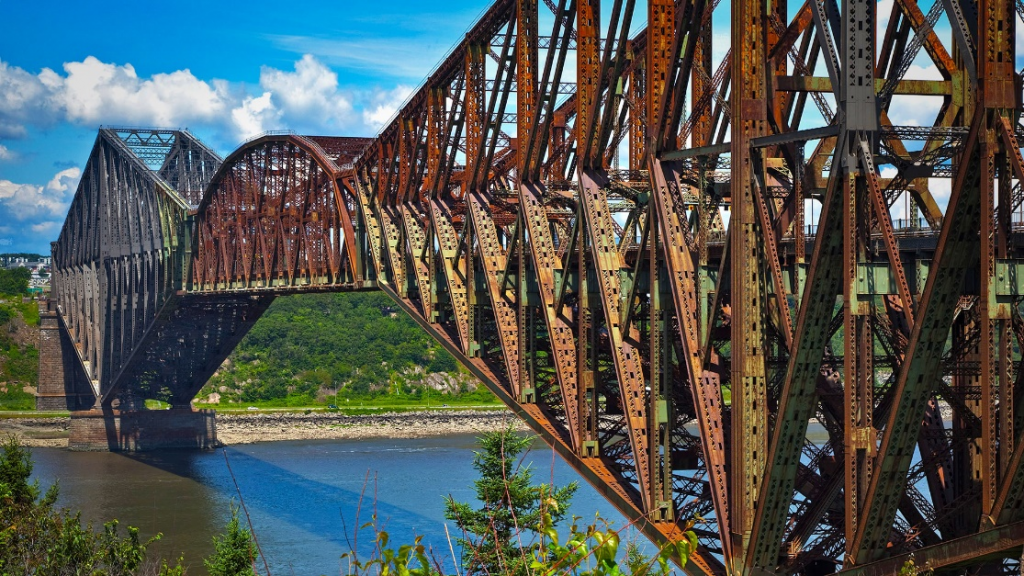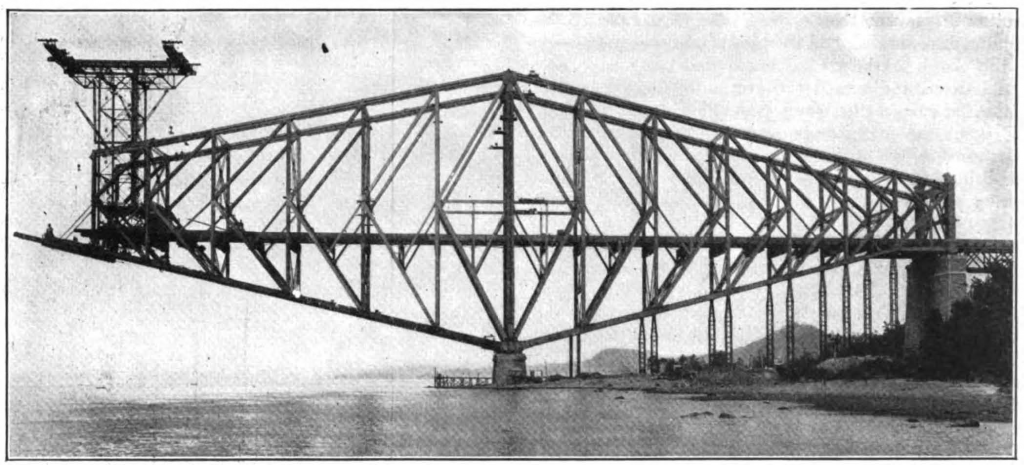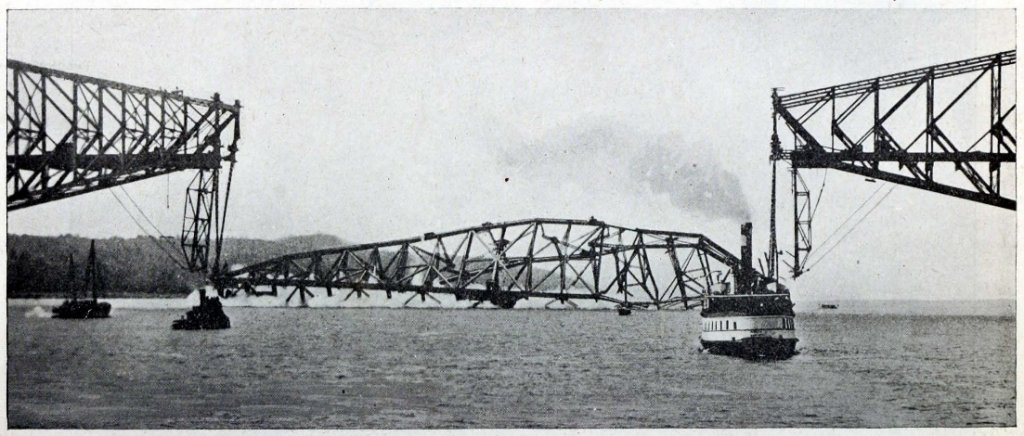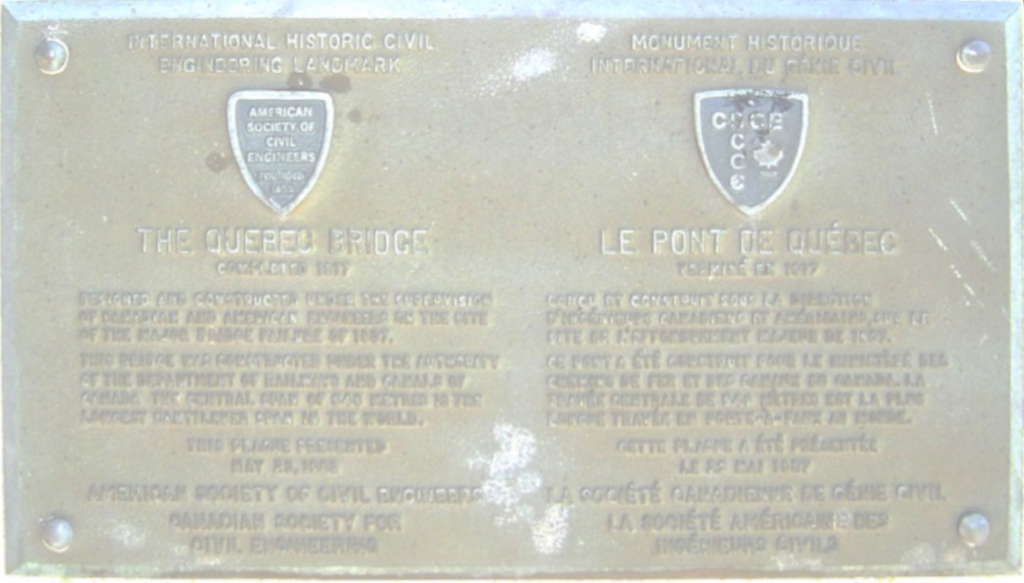This International Civil Engineering Landmark is commemorated jointly by CSCE and the ASCE (American Society of Civil Engineers).

Site Location: Lat.: 46° – 44’ – 46” N; Long.: 71° – 17’ – 17” W. (GPS: 46.7460433, -71.288093). The lanes on the bridge are one-way, southbound from Sainte-Foy to Lévis. From Trans-Canada Highway Autoroute 20, take Exit 312N to merge onto Autoroute 73 N toward Québec/Pont Pierre-Laporte. After 3.6 km, crossing the St. Laurence River on Pont Pierre-Laporte, take Exit 132 toward Avenue des Hôtels. After 0.2 km, turn left on Avenue des Hôtels (signs for Pont de Québec/Chemin Saint Louis) and, after 0.25 km, turn left to merge onto QC-175 S toward Pont de Québec, and drive across the bridge.
Plaque Location: On the face of a pedestal (GPS: 46.750147, -71.290260) in a small park at the east side of the north end of the bridge. From the directions above turn right, not left, on Avenue des Hôtels and park in the lot on the left. Follow roads and trails approximately 270 m in the south west direction towards the bridge, keeping the Quebec Aquarium on your left.

Description: The Québec Bridge is a steel cantilever bridge that carries road, rail and pedestrian traffic across the St. Lawrence River between Sainte-Foy and Lévis. The bridge has a main span of 549 m (1800 ft.) and a total length of 987 m (3238 ft.). The first design of this crossing collapsed during construction when compression chords near the root of the cantilever buckled on August 29, 1907, killing 75 workers. A subsequent Royal Commission of Inquiry blamed the collapse on: inadequate design by P. L. Szlapka, Design Engineer of the Phoenix Bridge Company (the steel fabricator and erector); inadequate checking by Theodore Cooper, Consulting Engineer for the Quebec Bridge and Railway Company (QBRC – the owner); and, the failure on the part of the QBRC to appoint an experienced bridge engineer as Chief Engineer.
A Board of Engineers was appointed in 1908 to prepare a new design, and on April 4th, 1911, the construction contract was signed with the St. Lawrence Bridge Company, a joint venture of the Dominion Bridge Co. Ltd. of Lachine and the Canadian Bridge Co. of Walkerville. On May 6th, 1911, Lt. Colonel Charles N. Monsarrat was appointed as the Chairman and Chief Engineer of the board. Other members included Ralph Modjeski, a consulting engineer from Chicago; Charles C. Schneider, Chief Engineer of the American Bridge Co.; and Phelps Johnson, President, and George Herrick Duggan, Chief Engineer, St. Lawrence Bridge Co. and Dominion Bridge Co. Ltd. Philip Louis Pratley worked extensively on the project, as a member of the engineering staff of the Board of Engineers and as a design engineer for the Dominion Bridge Co. Ltd. and the St. Lawrence Bridge Co. Ltd. A casting failed when the suspended span was being lifted on September 11, 1916, killing 13. A new suspended span was fabricated and successfully erected on September 20, 1917. A ceremonial train crossed the bridge on October 17, 1917.
The bridge was built as part of the National Transcontinental Railway, which was merged into the Canadian Government Railway and, in 1993, Canadian National Railway (CN), which was privatized in 1995. The bridge remains in service. It was identified in 2015 by the National Trust of Canada as one of the ten most endangered historic sites in Canada, due to long overdue paint and repair work.
South cantilever arm of first Québec Bridge on August 27, 1908, two days before the collapse. (Source: Quebec Bridge Report of the Government Board of Engineers, Vol. 1, 1919)
Wreckage of the cantilever and anchor arm, August 1907. (Source: Quebec Bridge Report of the Government Board of Engineers, Vol. 1, 1919).




Collapse of the suspended span during erection, September 11, 1916. (Source: Wikipedia)

George Herrick Duggan (1862-1946), lead designer of the Québec Bridge. (Source: historicbridges.org).
Historic Significance: The 543 m (1800 ft.) main span of the Quebec Bridge is the longest cantilever span in the world. It is the first major bridge to use the K-truss, proposed by Johnson, which greatly facilitated its erection, and the first bridge in North America to use nickel steel in its construction. Although prominent international experts served on the Board of Engineers, Canadians were largely responsible for its design and construction.
Thirty-three of the workers killed in the first collapse were Mohawk ironworkers from the Kahnawake reserve near Montréal, a devastating loss to this small indigenous community.

Plaque detail (Source: M. Frenette/C. Katsanis)
Plaque Wording: International Historic Civil Engineering Landmark. ASCE. CSCE. THE QUEBEC BRIDGE. Completed 1917. Designed and constructed under the supervision of Canadian and American engineers on the site of the major bridge failure of 1907. This bridge was constructed under the authority of the Department of Railways and Canals of Canada. The central span of 549 metres is the longest cantilever span in the world. This plaque presented May 23, 1987. American Society of Civil Engineers. Canadian Society for Civil Engineering.
Monument Historique International du Génie Civil. LE PONT DE QUEBEC. Terminé en 1917. Conçu et construit sous la direction d’ingénieurs canadiens et américains sur le site de l’effondrement majeur de 1907. Ce pont a été construit pur le ministére des Chemins de fer et des canaux du Canada. La travée centrale de 549 metres est la plus longue travée en porte-á-faux au monte. Cette plaque a été présentée le 23 mai 1987. La sociéte canadienne de genie civil. La sociéte américaine des ingénieurs civil.
Plaque Unveiling Ceremony: May 23, 1987. Present at the unveiling ceremony were: Chris Thompson, CSCE President; Dan Barge, ASCE President; Suzanne Duplessis, MP for Louis-Hébert; Gil Rémillard, Québec Minister of International Relations, and Andrée Boucher, Mayor of Sainte-Foy. Yves M. Giroux of Laval University described the historic significance of the bridge.
Links to Online Documentation:
Canada’s Historic Places, “Québec Bridge National Historic Site of Canada”.
National Film Board of Canada, “High Steel”, 1966
“Pont de Québec”, historicbridges.org
Susan Goldenberg, “A Community’s Loss”, Canada’s History, 2017.